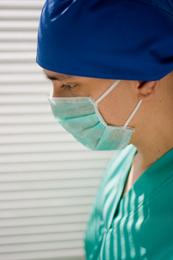Office Procedures
Colposcopy
 Colposcopy is a procedure used to magnify certain areas of the body and help diagnose abnormalities. A vulvar colposcopy typically examines lesions on the vulva and is often used to identify cancer or HPV. The procedure is done with a colposcope, a microscope that can help identify malignant lesions on the vulva. It is usually performed as a follow-up procedure to an abnormal pap smear. The exam itself is similar to a pap smear in that a speculum is inserted and the cervix may be cleaned. The colposcope is then placed to view the area at 10 to 40 times its normal size. If any abnormal cells are noticed, a biopsy of the tissue may be done. A colposcopy is a very safe procedure with few complications. Light bleeding or discharge for up to a week after the exam is normal.
Colposcopy is a procedure used to magnify certain areas of the body and help diagnose abnormalities. A vulvar colposcopy typically examines lesions on the vulva and is often used to identify cancer or HPV. The procedure is done with a colposcope, a microscope that can help identify malignant lesions on the vulva. It is usually performed as a follow-up procedure to an abnormal pap smear. The exam itself is similar to a pap smear in that a speculum is inserted and the cervix may be cleaned. The colposcope is then placed to view the area at 10 to 40 times its normal size. If any abnormal cells are noticed, a biopsy of the tissue may be done. A colposcopy is a very safe procedure with few complications. Light bleeding or discharge for up to a week after the exam is normal.
Loop Electrosurgical Excision Procedure (LEEP)
Loop electrosurgical excision procedure (LEEP) is used to treat abnormal cells on the surface of the cervix. During the procedure, the cells are removed to prevent development of cervical cancer. Wire loops attached to an electrosurgical generator cut away the affected tissue, causing the cells to heat and burst. The removed tissue is then sent to a lab for further evaluation. The procedure takes 20-30 minutes and can be performed in the office.
Hysteroscopy
A hysteroscopy is a procedure done to examine the lining of the uterus (endometrium) and identify, diagnose or treat abnormalities. The procedure uses a viewing tool called a hysteroscope, which has a light and camera at the end, and is inserted into the vagina and moved through the cervix to see the uterus. The hysteroscope projects an image onto a display screen for the doctor to view. The doctor may also take a small sample of tissue to examine more closely under a microscope.
A hysteroscopy may be done to determine the cause of abnormal bleeding or bleeding after menopause, determine the cause of infertility, find and remove fibroids or polyps and find and reposition an intrauterine device. A local or general anesthesia may be used to relax the patient and relieve any potential discomfort.
While this is a simple and safe procedure, a hysteroscopy is not recommended for everyone and certain conditions can affect the results or lead to side effects. Talk to your doctor if you think it may be right for you.
Cryosurgery
Cryosurgery, also known as cryotherapy, is a minimally invasive treatment that uses freezing cold temperatures to destroy abnormal tissue cells. These cells can include skin tumors, nodules, skin tags or prostate, liver and cervical cancer cells.
Doctors apply nitrogen or argon gas either directly on the skin or through a cryoprobe with image assistance for internal tumors. The diseased cells cannot survive extremely cold conditions and will be destroyed. Cryosurgery has a shorter treatment and recovery time than surgical procedures. Talk to your doctor if you think you may be a good candidate for cryosurgery.
Dilation and Curettage
Dilation and curettage (D&C) is a procedure to scrape and collect endometrium, the tissue inside the uterus. Dilation is the widening of the cervix which allows instruments to pass into the uterus, while curettage is the scraping of the uterine walls.
Why is the Dilation and Curettage Procedure Performed?
A dilation and curettage procedure is performed for several reasons. They are as follows:
- Diagnose uterine cancer or other conditions
- Remove tissue after a miscarriage
- Treat heavy bleeding
- Perform a therapeutic or elective abortion
- Investigate infertility
How is the Dilation and Curettage Procedure Performed?
A dilation and curettage is performed under general or local anesthesia. A speculum is inserted into the vagina to hold it open. Medication to numb the opening to the uterus may be applied at this time. A curette is then inserted to gently scrape the tissue.
